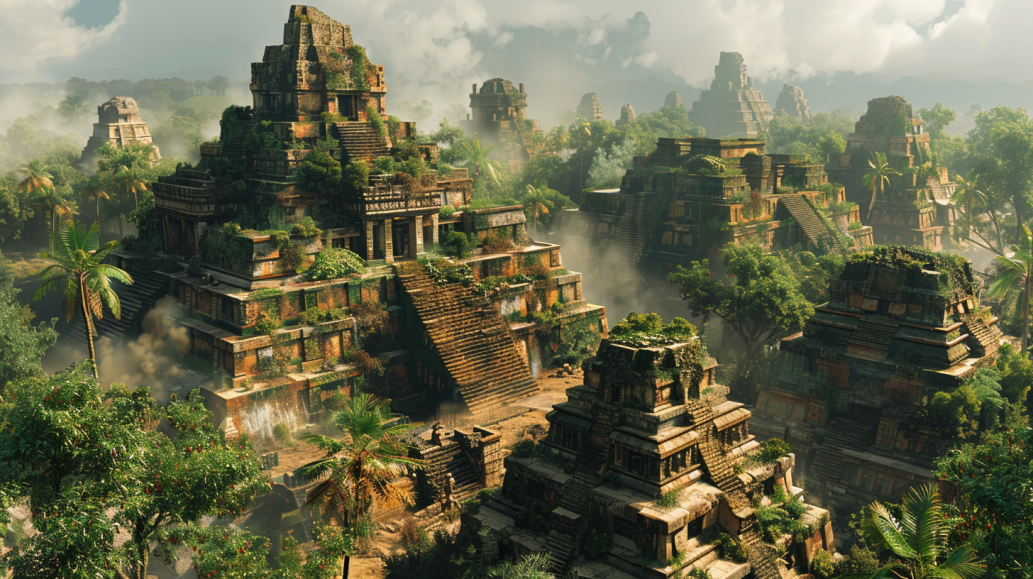Introduction
The Mayan Civilization, renowned for its advanced writing, astronomical systems, and impressive architecture, flourished in Central America for centuries. This ancient civilization, which peaked during the Classic Period (250-900 CE), left behind remarkable cities, pyramids, and intricate calendars. However, around 900 CE, many of their bustling cities were suddenly abandoned, leading to the mysterious collapse of this great civilization. Theories about their decline include severe drought, warfare, overpopulation, and resource depletion. Despite extensive research, the exact reasons behind the fall of the Mayans remain an enigma.
The Rise of the Mayan Civilization
Early Mayan Settlements
The Mayan civilization began to take shape around 2000 BCE with the establishment of agricultural communities. These early Mayans cultivated maize, beans, squash, and chili peppers, which became staples of their diet. Villages grew into city-states, each governed by its own ruler, contributing to a complex and interconnected society.
The Classic Period: A Golden Age
The Classic Period (250-900 CE) marks the peak of Mayan civilization. During this time, the Mayans built grand cities such as Tikal, Palenque, and Copán. They developed a sophisticated writing system using hieroglyphs and made significant advancements in mathematics and astronomy. The Mayans are credited with creating the concept of zero and devising a highly accurate calendar system.
Architectural Marvels
Mayan architecture is one of the civilization’s most enduring legacies. They constructed towering pyramids, palaces, and observatories, often adorned with elaborate carvings and stucco reliefs. The city of Chichen Itza, with its iconic El Castillo pyramid, and the Temple of the Inscriptions in Palenque are prime examples of Mayan architectural prowess.
The Sudden Decline
The Abandonment of Cities
Around 900 CE, many of the major Mayan cities in the southern lowlands were abandoned. This sudden decline marked the end of the Classic Period. The reasons behind this mass exodus remain a topic of intense debate among scholars and archaeologists.
Theories Explaining the Collapse
Severe Drought
One leading theory suggests that prolonged droughts played a significant role in the Mayan collapse. Climate data from lake sediments and cave formations indicate that the region experienced severe droughts during the late Classic Period. These droughts would have led to crop failures, food shortages, and increased mortality rates.
Warfare and Political Instability
Another theory points to internal warfare and political instability as contributing factors. The Mayan city-states often engaged in conflict with one another, vying for power and resources. Evidence of fortifications and mass graves suggests that warfare became more frequent and destructive towards the end of the Classic Period.
Overpopulation and Resource Depletion
Overpopulation and resource depletion are also considered possible causes of the Mayan decline. As the population grew, the demand for food, water, and land increased. Deforestation and soil degradation may have reduced agricultural productivity, making it difficult to sustain large urban centers.
Environmental Changes
Environmental changes, such as soil erosion and changes in river courses, could have further strained the Mayan society. These changes would have affected agricultural yields and the availability of fresh water, exacerbating the challenges faced by the Mayans.
The Post-Classic Period
Northern Mayan Cities
While the southern lowland cities were abandoned, some Mayan cities in the northern Yucatan Peninsula, such as Uxmal and Chichen Itza, continued to thrive during the Post-Classic Period (900-1500 CE). These cities maintained trade networks and cultural practices, although they too eventually experienced decline.
The Arrival of the Spanish
The final blow to the Mayan civilization came with the arrival of Spanish conquistadors in the early 16th century. The Spanish conquest led to the collapse of the remaining Mayan polities and the integration of the region into the Spanish Empire.
Legacy of the Mayan Civilization
Contributions to Science and Culture
The Mayan civilization made lasting contributions to science, particularly in astronomy and mathematics. Their calendar system, based on precise astronomical observations, was one of the most accurate in the ancient world. Mayan art, literature, and mythology continue to inspire and fascinate people today.
Modern-Day Maya
Descendants of the ancient Mayans still live in parts of Mexico, Guatemala, Belize, Honduras, and El Salvador. They maintain many aspects of their ancestral culture, including language, traditional clothing, and religious practices. Modern Maya communities continue to honor their rich heritage while navigating the challenges of contemporary life.
Conclusion
The fall of the Mayan civilization remains one of history’s greatest mysteries. Theories such as severe drought, warfare, overpopulation, and resource depletion offer plausible explanations, but no single cause can fully account for the complexity of the collapse. The legacy of the Mayans endures through their remarkable achievements in architecture, astronomy, and writing, as well as the vibrant culture of their descendants. As researchers continue to uncover new evidence, the enigmatic story of the Mayan decline may one day be fully understood.
FAQs
1. What was the primary cause of the Mayan civilization’s collapse?
There is no single primary cause. The collapse was likely due to a combination of factors, including severe drought, warfare, overpopulation, and resource depletion.
2. When did the Mayan civilization reach its peak?
The Mayan civilization reached its peak during the Classic Period, between 250 and 900 CE.
3. Are there still Mayan people today?
Yes, descendants of the ancient Mayans still live in parts of Mexico, Guatemala, Belize, Honduras, and El Salvador. They maintain many cultural traditions and practices.
4. What are some of the most famous Mayan cities?
Some of the most famous Mayan cities include Tikal, Palenque, Copán, Chichen Itza, and Uxmal.
5. What were some of the Mayan civilization’s key achievements?
The Mayans made significant advancements in writing, mathematics, and astronomy. They created a complex calendar system, developed the concept of zero, and built impressive architectural structures.

